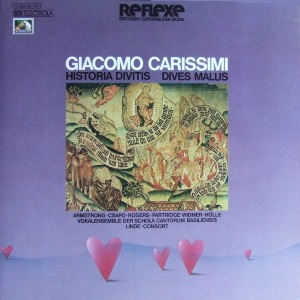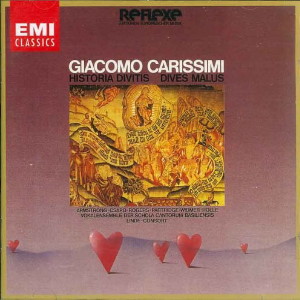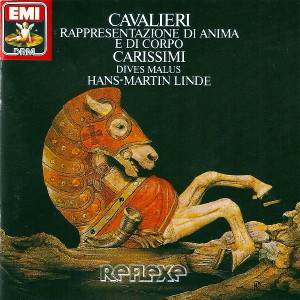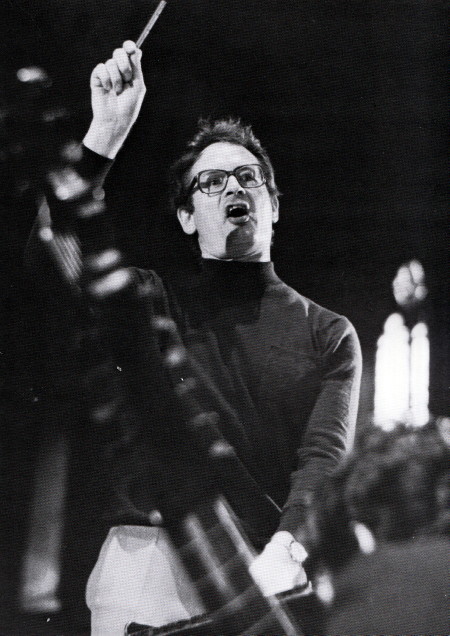 |
1 LP -
1C 063-30 121 - (c) 1974
|

|
| 1 CD - 8
26490 2 - (c) 2000 |
 |
2 CD -
CMS 7 63421 2 (Carissimi) - (c) 1990
|
|
| GIACOMO CARISSIMI (1605-1674)
- Dives Malus (Historia Divitis) |
|
|
|
|
|
| Gregorio
Allegri (1582-1652) |
|
|
| Symphonia in G
für Streicher und Basso continuo |
4' 47" |
|
|
|
|
| Giacomo
Carissimi (1605-1674) |
|
|
| DIVES MALUS
(HISTORIA DIVITIS) - Oratorium
für Soli, Chor, Streicher und Basso
continuo |
|
|
| - Erat vir
quidam opulentissimus - Historicus
(Sopran I) |
2' 33" |
|
| - Factum est
autem ut moreretur - Historicus
(Sopran II) |
1' 05" |
|
| - Iam satis
edisti - Soli und
Chor |
2' 59" |
|
| - Heu miser,
quid audis? - Dives (Tenor
I), Soli und Chor |
1' 17" |
|
| - O spes meas
fallaces - Dives, Sopran
I, Tenor II, Baß II, Sopran II |
2' 52" |
|
| - Morere,
infelix! - Soli und Chor |
1' 34" |
|
- Sat mensas
mille plenas - Sopran II,
Tenor II, Cantus II, Cantus I,
Soli und Chor
|
2' 18" |
|
|
|
|
| - En vitae
suprema - Sopran II,
Sopran I |
3' 57" |
|
| - Heu me miserum
- Dives, Soli und
Chor |
4' 40" |
|
| - Mortuus est
ergo dives, et sepultus - Historicus
(Tenor I) |
0' 48" |
|
| - Pater
Abraham, miserere mei - Dives,
Abraham |
2' 37" |
|
| -
O dives miserrime - Soli
und Chor |
3' 45" |
|
| -
Quam stulti sunt, quam vani -
Soli und Chor, Tenor II |
1' 58" |
|
| -
Avernales inter poenas - Tenor
II |
3' 55" |
|
|
|
|
| VOKALENSEMBLE DER
SCHOLA CANTORUM BASILIENSIS |
|
-
Sheila Armstrong, Sopran
|
|
| -
Eva Csapò, Sopran |
|
| -
Nigel Rogers, Tenor |
|
| -
Ian Partridge, Tenor |
|
| -
Kurt Widmer, Baß |
|
| -
Matthias Hölle, Baß |
|
|
|
| LINDE-CONSORT
/ Hans-Martin Linde, Leitung |
|
| -
Herbert Höver, Miguel de la Fuente,
Adelheid Schäfer, Christopher
Schmidt, Zukimi Kambe, Violine
alter Mensur |
|
| -
Dorothea Jappe, Violine und
Viola alter Mensur |
|
| -
Michael Jappe, Violoncello alter
Mensur |
|
| -
Angelo Viale, Violone |
|
| -
Dieter Kirsch, Theorbe |
|
| -
Konrad Ragossnig, Laute |
|
| -
Toyohiko Satoh, Chitarrone |
|
| -
Gottfried Bach, Cembalo
(Eckehart Merydorf, nach Daniel
Dulcken, 1755) |
|
| -
Eduard Müller, Orgelpositiv
(Bernhard Fleig, Hersberg) |
|
|
|
|
|
Luogo
e data di registrazione |
|
Tituskirche,
Basel (Svizzera) - 26-30 aprile
1974 |
|
|
Registrazione: live /
studio |
|
studio |
|
|
Producer / Engineer |
|
Gerd
Berg / Johann-Nikolaus Matthes /
Wolfgang Gülich
|
|
|
Prima Edizione LP |
|
EMI
Electrola "Reflexe" - 1C 063-30
121 - (1 lp) - durata 41' 13" -
(p) 1974 - Analogico |
|
|
Prima Edizione CD |
|
EMI
"Classics" - CMS 7 63421 2 - (2
cd) - durata 58' 41" - 63' 07" -
(c) 1990 - ADD - (Carissimi)
|
|
|
Edizione CD |
|
EMI
"Classics" - 8 26490 2 - (1 cd) -
durata 41' 13" - (c) 2000 - ADD |
|
|
Note |
|
- |
|
|
|
|
|
 In
the historia divitis
Carissimi combined the
scriptural history on the rich
man with dramatic passages
that embellish the story in a
nearly theatrical way. In
these sections favorite and
cappella choir - partly
engaged in dialogue with the dives
- unite and from great sound
blocks. The narration by the historicus
and the words by the
characters (Dives, Abraham)
are relatively simple, but
most impressive solo
declamations with figured bass
accompaniment. A third element
is given by comtemplative and
didactic passages which demand
the novel type of cantare
con affetto. The result
of these contrasts is a
charming combination of the
rather traditional double
choir style with modern
monody, of plain, but ever
impressive harmony with casual
chromatic passages, of complex
sound with line. The
performers are supposed to
achieve the plasticity of a
‘didactic play’ by means of
deliberately formed contrasts.
Again and again the soloists
must decide which is the
appropriate dimension and
significant distribution of
intesifying means in
performance (such as
ornamentation, dynamic and
agogic accent). The
distribution ofthe figured
bass as well - which the
composer has not written in
full - must contribute to the
deepening of the contents of
the biblical text and the
poetical work. In the
present recording the theorbo
and lute were employed as
ornamenting instruments.
According to Agazzari (1607)
this means “the running up and
down of the fingers on the
strings”, that is the bass
line is ornamented for the
embellishment of the sound
picture. The organ, chitarrone
and partly the harpsichord
were more frequently employed
as ground instruments. In the
corresponding parts of the
composition the provide a
calm, all-combining colour. In the
solo parts each character is
given typifying continuo
accompaniment. Some
ornamental, text-interpreting
figures have been written in
full by the composer. In most
cases, however, the singer
himself must find the
appropriate means of
performance (such as rising
and sinking voice,
coloratura). They result from
the right understanding of the
text and the knowledge of
contemporary sources. The part
of the strings is still small
in Carissimi. It is
mostly confined to ritornels
with organizing function in
form and intensification of
the tutti. In
the historia divitis
Carissimi combined the
scriptural history on the rich
man with dramatic passages
that embellish the story in a
nearly theatrical way. In
these sections favorite and
cappella choir - partly
engaged in dialogue with the dives
- unite and from great sound
blocks. The narration by the historicus
and the words by the
characters (Dives, Abraham)
are relatively simple, but
most impressive solo
declamations with figured bass
accompaniment. A third element
is given by comtemplative and
didactic passages which demand
the novel type of cantare
con affetto. The result
of these contrasts is a
charming combination of the
rather traditional double
choir style with modern
monody, of plain, but ever
impressive harmony with casual
chromatic passages, of complex
sound with line. The
performers are supposed to
achieve the plasticity of a
‘didactic play’ by means of
deliberately formed contrasts.
Again and again the soloists
must decide which is the
appropriate dimension and
significant distribution of
intesifying means in
performance (such as
ornamentation, dynamic and
agogic accent). The
distribution ofthe figured
bass as well - which the
composer has not written in
full - must contribute to the
deepening of the contents of
the biblical text and the
poetical work. In the
present recording the theorbo
and lute were employed as
ornamenting instruments.
According to Agazzari (1607)
this means “the running up and
down of the fingers on the
strings”, that is the bass
line is ornamented for the
embellishment of the sound
picture. The organ, chitarrone
and partly the harpsichord
were more frequently employed
as ground instruments. In the
corresponding parts of the
composition the provide a
calm, all-combining colour. In the
solo parts each character is
given typifying continuo
accompaniment. Some
ornamental, text-interpreting
figures have been written in
full by the composer. In most
cases, however, the singer
himself must find the
appropriate means of
performance (such as rising
and sinking voice,
coloratura). They result from
the right understanding of the
text and the knowledge of
contemporary sources. The part
of the strings is still small
in Carissimi. It is
mostly confined to ritornels
with organizing function in
form and intensification of
the tutti.
Hans-Martin
Linde
Translation
by Gudrun Meier
The orgins of oratorio are
closely bound up with the lay
piety which was particularly
marked in Italy and which gave
rise, in the 13th century, to
the founding of organised
fraternities. “Oratorio” first
denoted the chapel, or
oratory, in which the members
of the order gathered to sing
and worship. Music played a
major part in these devotions,
and it was in this setting
that, in Rome in the first
half of the 17th century, the
gradual evolution of oratorio
as a musical form came about.
The form had various
antecedents, the most
important of these being the
religious dialogue set to
music. Whereas the “oratorio
volgare", sung in italian,
attracted a wide public to S.
Maria
in Vallicella, the tradition
of the “oratorio latino” was
fostered at the church of S. Marcello
by the “Arciconfraternita del
SS. Crocifisso", a socially
and intellectually more
exclusive community which had
been active since 1526. The
Italian oratorio acquired a
widespread following in the
course of the 17th century,
both in Italy
itself and abroad, but the
Crocifisso Fraternity’s
“oratorio” maintained its
position at the centre of the
form’s Latin branch. Among the
composers of oratorio latino
an equally central role was
played by one person: -
Giacomo Carissimi. He was
born in Marino
(Castelli Romani) in 1605, the son
of a fairly prosperous cooper,
and had held posts in the
cathedrals of Tivoli
(1623-1627) and Assisi
(1627-1629) before being
appointed music teacher and
Kapellmeister of the
Sant’Apollinare church at the
Jesuit Collegium Germanicum Hungaricum
in Rome. Here he was to spend
the rest of a life crowned
with fame and success (the
latter also in financial terms
- much,
to quote a peevish remark by a
member of the college, to his
detriment).
Carissimißs Latin oratorios
represent at once the
beginning of the genre and its
zenith. But he was not its
creator. The first dawning of
both the Latin and Italian
oratorio is somewhat obscure,
since the earlier, traditional
material surviving is both
scant and fragmentary.
Moreover,
like the oratorios of
Carissimi himself, it can
hardly be dated. However,
we do know, from the French
traveller André Maugars
1639 account of the Crocifisso
Fraternity’s performances,
that these were then already
an established institution -
suggesting that they must have
started considerably earlier.
Maugars
contrasts the Sant‘Apollinare
performances with the
grandiose presentations at S.
Maria
sopra Minerva (with no less
than ten choirs positioned
around the church) and refers
to them as a “different sort
of music”, known as the “stile
recitativo”.
The service would begin with a
psalm motet, followed in turn
by an instrumental piece, a
story from the Old Testament,
a sermon and, finally, the
day’s reading from the
Gospels, the two Biblical
texts being rendered musically
with parts assigned. If
Carissimi, in these
“recitativo" parts, is
standing on ground provided by
the later works of Monteverdi,
the choruses - which, though
not mentioned by Maugars,
are nonetheless important in
Carissimi - show the lingering
influence of the Palestrina
and polychoral Venetian
styles.
Carissimi was not an
innovator; his musical
resources were simple, but
used with perfect mastery and
artistic ingenuity. In the
baroque era the art of
faithfully reproducing the
spoken word in music was held
to be one of a composer’s
highest attributes. And it is
for this merit above all that
Carissimi’s works have, all
along, earned fame and
admiration. Just as, on the
formal plane, both individual
word accentuation and the
broader grammatical groupings
are perfectly rendered,
so, too, where content is
concerned, are the individual
concepts and the greater
bodies of meaning transcending
these. All this makes Giacomo
Carissimi doubly deserving of
our acclamation as the master
of musical oratorio.
Theophil
Antonicek
Translation
by R. C. Sigee
In accordance with
contemporary practice the
performance of the oratorio
Dives Malus by Carissimi
was preceded by that of the
Symphonia in G by Gregorio
Allegri. |
|
|
EMI Electrola
"Reflexe"
|
|
|
|

